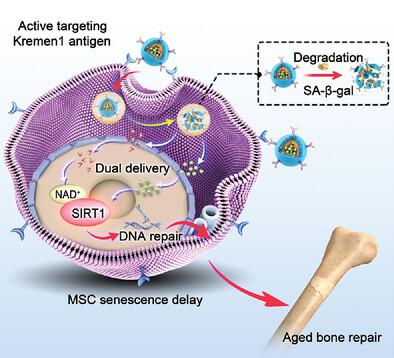Our official English website, www.x-mol.net, welcomes your
feedback! (Note: you will need to create a separate account there.)
Senescence-Targeted and NAD+-Dependent SIRT1-Activated Nanoplatform to Counteract Stem Cell Senescence for Promoting Aged Bone Regeneration
Small ( IF 13.0 ) Pub Date : 2023-11-10 , DOI: 10.1002/smll.202304433 Ying Wang 1 , Fangru Xie 1 , Zirui He 1 , Lingbin Che 2 , Xi Chen 1 , Yuan Yuan 1 , Changsheng Liu 1
Small ( IF 13.0 ) Pub Date : 2023-11-10 , DOI: 10.1002/smll.202304433 Ying Wang 1 , Fangru Xie 1 , Zirui He 1 , Lingbin Che 2 , Xi Chen 1 , Yuan Yuan 1 , Changsheng Liu 1
Affiliation

|
Age-related bone defects are a leading cause of disability and mortality in elderly individuals, and targeted therapy to delay the senescence of bone marrow-derived mesenchymal stem cells (MSCs) has emerged as a promising strategy to rejuvenate bone regeneration in aged scenarios. More specifically, activating the nicotinamide adenine dinucleotide (NAD+)-dependent sirtuin 1 (SIRT1) pathway is demonstrated to effectively counteract MSC senescence and thus promote osteogenesis. Herein, based on an inventively identified senescent MSC-specific surface marker Kremen1, a senescence-targeted and NAD+ dependent SIRT1 activated nanoplatform is fabricated with a dual delivery of resveratrol (RSV) (SIRT1 promoter) and nicotinamide riboside (NR, NAD+ precursor). This targeting nanoplatform exhibits a strong affinity for senescent MSCs through conjugation with anti-Kremen1 antibodies and enables specifically responsive release of NR and RSV in lysosomes via senescence-associated β-galactosidase-stimulated enzymatic hydrolysis of the hydrophilic chain. Furthermore, this nanoplatform performs well in promoting aged bone formation both in vitro and in vivo by boosting NAD+, activating SIRT1, and delaying MSC senescence. For the first time, a novel senescent MSC-specific surface marker is identified and aged bone repair is rejuvenated by delaying senescence of MSCs using an active targeting platform. This discovery opens up new insights for nanotherapeutics aimed at age-related diseases.
中文翻译:

衰老靶向和 NAD+ 依赖性 SIRT1 激活纳米平台可对抗干细胞衰老,促进老年骨再生
与年龄相关的骨缺陷是老年人残疾和死亡的主要原因,延缓骨髓间充质干细胞(MSC)衰老的靶向治疗已成为在老年情况下恢复骨再生的有前景的策略。更具体地说,激活烟酰胺腺嘌呤二核苷酸 (NAD + ) 依赖性沉默调节蛋白 1 (SIRT1) 途径被证明可以有效对抗 MSC 衰老,从而促进成骨。在此,基于创造性鉴定的衰老 MSC 特异性表面标记 Kremen1,通过白藜芦醇 (RSV)(SIRT1 启动子)和烟酰胺核苷(NR、NAD +前体)的双重递送,制造了衰老靶向且 NAD +依赖性 SIRT1 激活的纳米平台。 )。这种靶向纳米平台通过与抗 Kremen1 抗体缀合,对衰老 MSC 表现出很强的亲和力,并通过衰老相关的 β-半乳糖苷酶刺激的亲水链酶水解,在溶酶体中特异性响应释放 NR 和 RSV。此外,该纳米平台通过增强 NAD + 、激活 SIRT1 和延缓 MSC 衰老,在体外和体内促进衰老骨形成方面表现良好。首次鉴定出一种新型的衰老 MSC 特异性表面标记物,并通过使用主动靶向平台延迟 MSC 的衰老来恢复老化的骨修复。这一发现为针对年龄相关疾病的纳米疗法开辟了新的见解。
更新日期:2023-11-10
中文翻译:

衰老靶向和 NAD+ 依赖性 SIRT1 激活纳米平台可对抗干细胞衰老,促进老年骨再生
与年龄相关的骨缺陷是老年人残疾和死亡的主要原因,延缓骨髓间充质干细胞(MSC)衰老的靶向治疗已成为在老年情况下恢复骨再生的有前景的策略。更具体地说,激活烟酰胺腺嘌呤二核苷酸 (NAD + ) 依赖性沉默调节蛋白 1 (SIRT1) 途径被证明可以有效对抗 MSC 衰老,从而促进成骨。在此,基于创造性鉴定的衰老 MSC 特异性表面标记 Kremen1,通过白藜芦醇 (RSV)(SIRT1 启动子)和烟酰胺核苷(NR、NAD +前体)的双重递送,制造了衰老靶向且 NAD +依赖性 SIRT1 激活的纳米平台。 )。这种靶向纳米平台通过与抗 Kremen1 抗体缀合,对衰老 MSC 表现出很强的亲和力,并通过衰老相关的 β-半乳糖苷酶刺激的亲水链酶水解,在溶酶体中特异性响应释放 NR 和 RSV。此外,该纳米平台通过增强 NAD + 、激活 SIRT1 和延缓 MSC 衰老,在体外和体内促进衰老骨形成方面表现良好。首次鉴定出一种新型的衰老 MSC 特异性表面标记物,并通过使用主动靶向平台延迟 MSC 的衰老来恢复老化的骨修复。这一发现为针对年龄相关疾病的纳米疗法开辟了新的见解。











































 京公网安备 11010802027423号
京公网安备 11010802027423号